
Stages in the Hajj Pilgrimage
The stages of the rites of the Hajj (there being slight differences in various schools of Islamic law and views of jurists).
1. Pilgrims should arrive by the seventh day of the month of pilgrimage to the vicinity of Mecca where the men must purify themselves ritually and put on the ihram or dress of pilgrimage consisting of two pieces of white seamless cloth which is often used later for one’s shroud. The women must also make the rites of purification but do not have to put on the ihram as do men. What is expected of them is to wear clean and simple clothing which is modest according to Islamic norms of female dress.
2. Upon arrival at the Great Mosque, the pilgrims must perform seven tawaf or circumambulations around the Ka’bah and then perform the sa’y between Safa and Marwah seven times. A special sermon is preached in the Great Mosque of Mecca.
3. In the morning of the eighth day, called yawm al-tarwiyah or “day of watering” because water is provided on this day for the next days, all pilgrims leave Mecca to an area outside the city called Mina where they spend the night. If, for some reason, this is impossible, the pilgrims may proceed directly from Mecca to Arafat on the ninth day.

Pilgrims leaving Mina for Arafat in the gray of the morning of the ninth day of Dhu al-hijjah (the twelfth month of the Islamic calendar designated as the month for the annual Hajj).
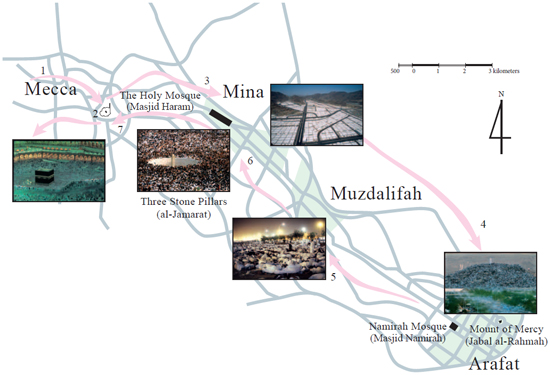
4. In the morning of the ninth day, all pilgrims leave Mina for the plain of Arafat. Here, from noon to evening, the Noble Qur’an and prayers are recited (wuquf) and people try to climb Jabal al-Rahmah, the Mount of Mercy at the center of the plain of Arafat.
5. With sundown as the signal, pilgrims leave Arafat for Muzdalifah, which lies midway to Mina, and spend the night there. While there, they gather small pebbles (traditionally ten) to be used the next day at the rite of stone throwing.
6. After midnight or at dawn, pilgrims move to Mina and proceed to the largest stone pillar (called Jamarah of Aqabah) standing at the western edge of the three pillars located there. They then throw the stones they gathered earlier at the pillar symbolizing the Devil. The rite is done with consciousness that in throwing the stones at the pillar one is also casting away the evil in one’s heart and soul. After this rite, an animal is usually sacrificed (hence the name of the celebration at the end of the pilgrimage as the ’id of Sacrifice).
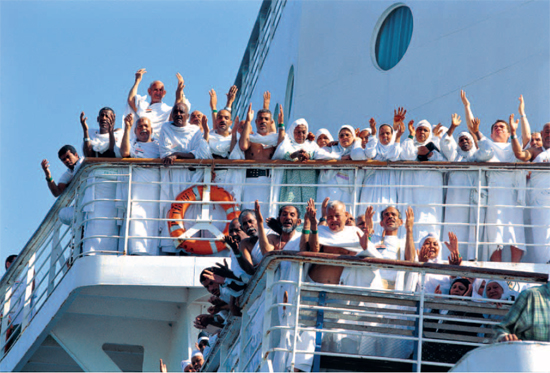
A group of Egyptian pilgrims arrive at the port of Jeddah. Although most pilgrims arrive by plane nowadays, chartered ships still ply the routes to Saudi Arabia from Egypt, Sudan and Pakistan during the Hajj season.
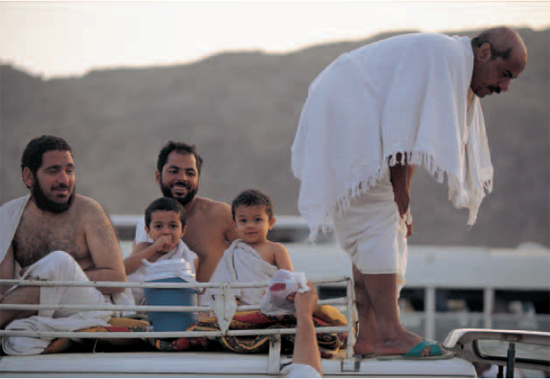
During the Hajj, all available vehicles in Mecca are in use.

A group of pilgrims from Bangladesh at a standstill in congested traffic on the way to Arafat from Mina.
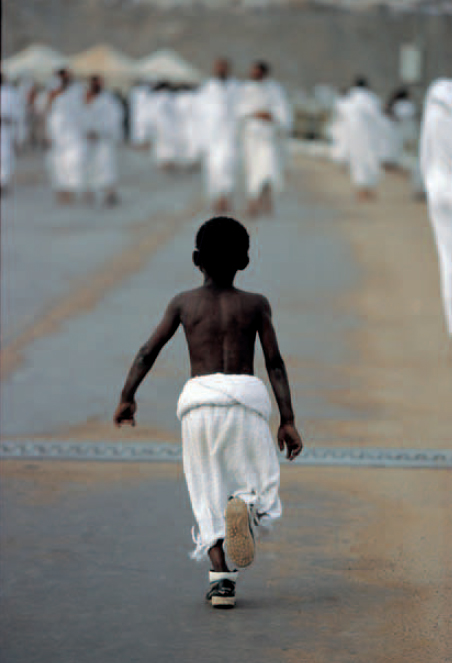
A boy in ihram, the pilgrim’s costume made of two pieces of white cotton cloth, following his parents during the Hajj.

Mina, where some two million people throng during the Hajj. Tents are allocated to pilgrims in groups according to their country of origin, the arrangements being made by a special agency called the Mutawalla, which is in charge of all travel arrangements for the pilgrims.

Pilgrims of Indian origin from South Africa performing the maghrib prayers at Mina. In contrast to what one observes in Arab countries, the women are standing not behind but adjacent to the men.

The national flag of Saudi Arabia, bearing the Islamic testimony of faith “There is no god but Allah and Muhammad is his Messenger,” flies from an escort car of the group of pilgrims who are guests of the governor of Mecca.
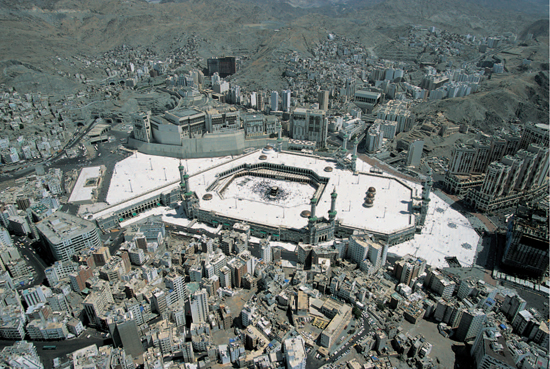
The Grand Mosque on the Day of Arafat, the ninth day of the month of pilgrimage, in 2000. With two million pilgrims in Arafat on this day, the kiswah, the black cloth covering the Ka’bah, is being changed in the empty mosque.

Tents in Mina on the ninth day of the month of pilgrimage. A city of semi-permanent tents, fully air-conditioned and made of fireproof materials, have replaced those destroyed by fire in 1997. On this day, Mina is deserted while everyone visits Arafat.
Men have some of their hair cut off and the ihram is removed. Pilgrims stay there for two more days, on the tenth and eleventh, during which stones are thrown at the two smaller pillars, also representing the Devil, and then return to Mecca where the final circumambulation of parting (tawaf al-ifadah) is performed. Most jurists have given the view that the tawaf at the Ka’bah should be done on the tenth day.
7. All pilgrims leave Mina by the twelfth day and return to Mecca where those who had not completed the final tawaf do so. Then begins the great celebration of Id al-adha, the Feast of Sacrifice, and the pilgrims gain the honorific titles of hajji for men and hajjiyah for women.
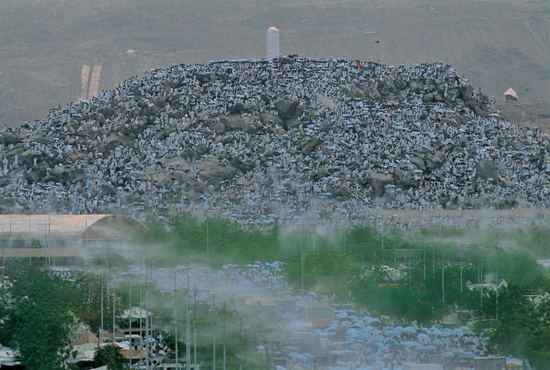
Pilgrims on the Mount of Mercy (Rahman) at Arafat on the ninth day of the month of pilgrimage and the climax of the rites. Here they perform wuquf, which consists of the recitation of the Noble Qur’an and intense prayer with all their heart. Water sprinklers function all day to relieve the excruciating heat.

Pilgrims performing wuquf at Arafat. During the rites of pilgrimage, people recite continuously the talbiyah, which is a prayer in praise of God starting with “labbayka, allahumma labbayk” (At Thy Service, O Lord, at Thy Service).
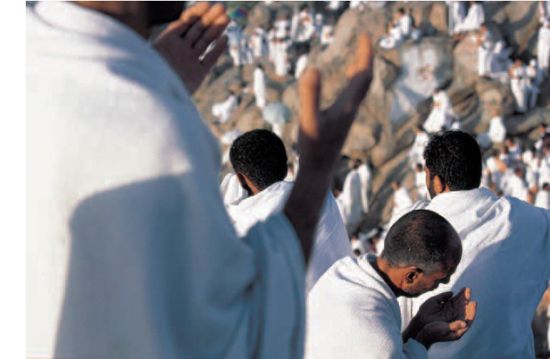

Pilgrims performing wuquf at the Mount of Mercy. Nothing is allowed to be worn besides the ihram, but one is permitted to carry a parasol to ward off the sun.

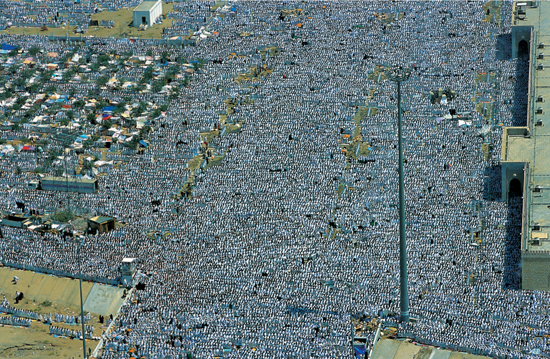
The climax of the Day of Arafat. Two million pilgrims attend the noon prayer (dhuhr), which is shortened and combined with the afternoon prayer (asr). This is followed by a sermon reminding the pilgrims of the Day of Judgement.
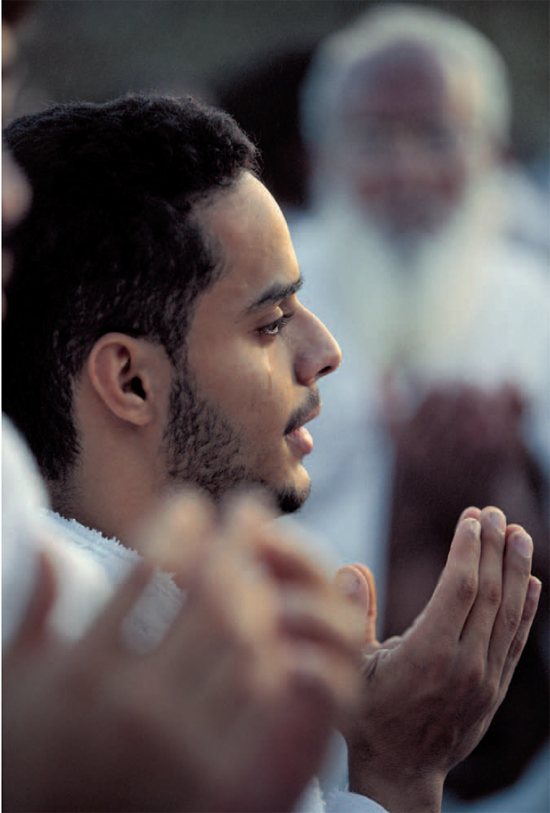
Pilgrims performing the wuquf are filled with emotion. Many shed tears before they leave Arafat.
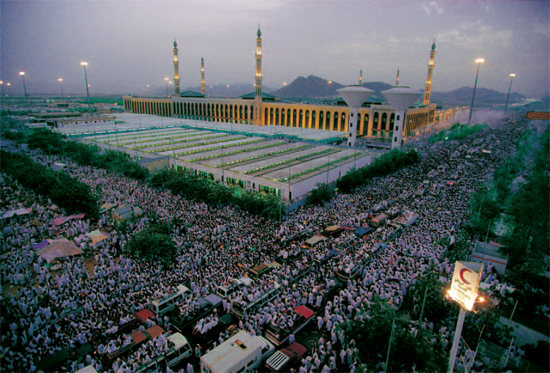
A vast crowd leaving Arafat at the moment of sunset. At this time everyone, whether walking or in cars, prays audibly and the deep sound of the prayers reverberates throughout the vast plains of Arafat. The building in the background is the Namirah Mosque.
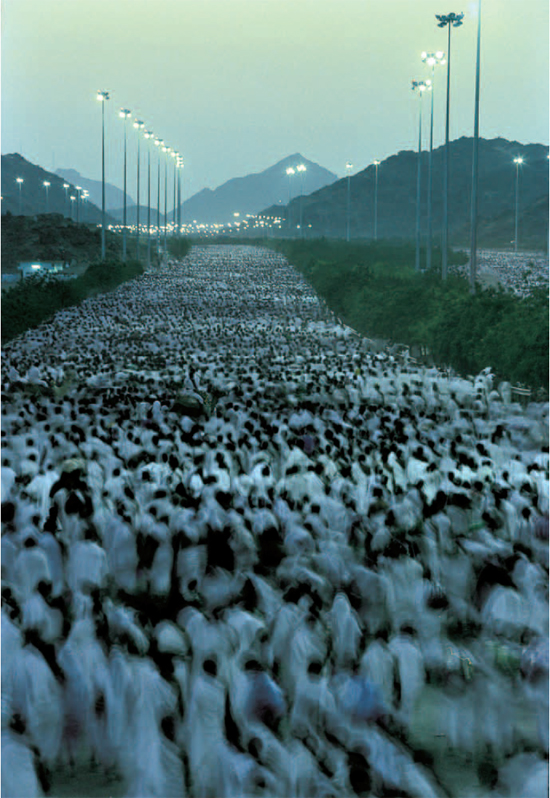
A vast crowd leaving Arafat for Muzdalifah at the moment of sunset. There are eight motorways and two pedestrian roads between Arafat and Muzdalifah, along which the two million pilgrims make their way.
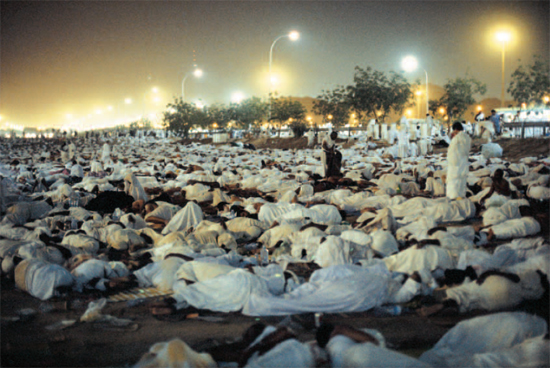
Pilgrims arriving from Arafat to Muzdalifah must spend their time here after midnight. Therefore, the wasteland of Muzdalifah becomes so crowded that there is hardly space to put one’s foot. Here, most pilgrims gather the stones which they will cast later in Mina.

On the tenth day, the pilgrims who have returned to Mina gather for the rite of the casting of stones at the pillars symbolizing the Devil. The area around the pillars is extremely crowded and dangerous for women, children and the elderly, who may therefore ask one of the men accompanying them to perform the rite for them. On this day, stone is cast only at the largest of the pillars.

The rite of the casting of stones at the two smaller pillars, which like the larger one symbolize the forces of evil, takes place. The pillars are called Jamarat in Arabic.
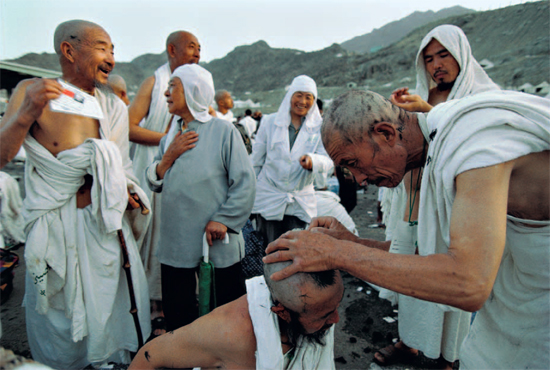
It is traditional for people to cut off hair after the rite of the casting of stones. Women and some men cut only a lock or two of their hair while other men shave their heads completely, as seen here.
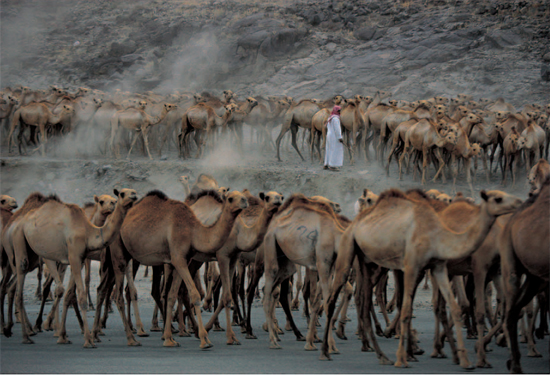
The end of the Hajj is marked by the sacrifice of an animal in celebration of the sacrifice of the prophet Abraham (Ibrahim). Here, a herd of camels is being brought for sacrifice. The celebration at the end of the pilgrimage is called Id al-adha and it lasts four days, during which those who have made the Hajj before often also perform the sacrifice of an animal in their home town, the meat then being given to the poor.

Pilgrims used to slaughter animals for the sacrifice themselves, but now it is mostly carried out in the slaughter houses in Muzdalifah with the exception of a few pilgrims who do it themselves. The meat is distributed to the pilgrims. This photograph shows the evening meal on the eighth day of the month of pilgrimage.
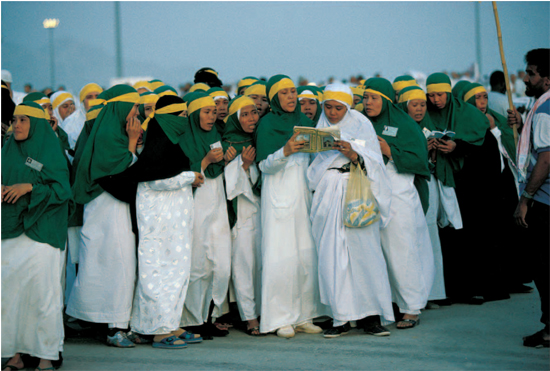
A group of pilgrims from Indonesia reciting prayers after the rite of casting of stones. All women, even those who hide their faces behind a veil in their own country, perform the pilgrimage with their faces revealed and only their hair covered.

Men and women both wear their best clothing for the Id al-adha, the women usually dressing in black or white. But there is much diversity in traditional Islamic dress, as the colorful habit of this group of African women reveals.
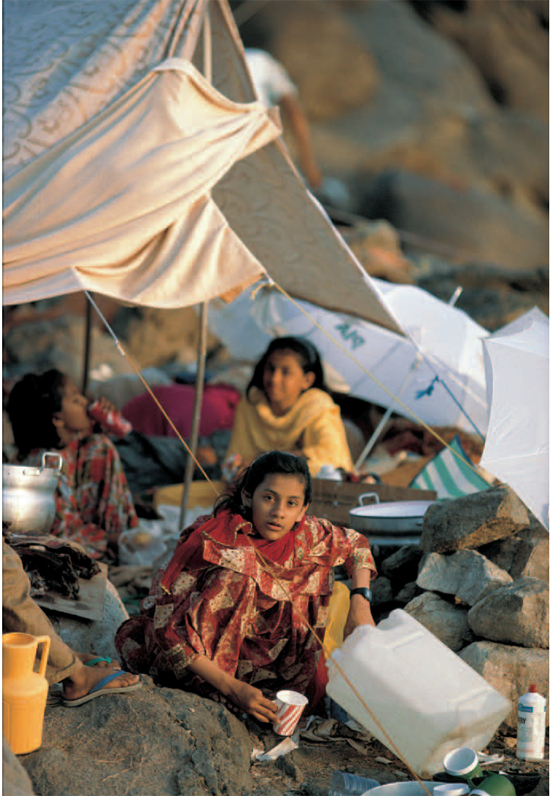
Those who pitch tents on hilltops or surroundings are usually foreign workers in Saudi Arabia who often make the pilgrimage individually. There are some five million such workers and many among them perform the annual pilgrimage every year.
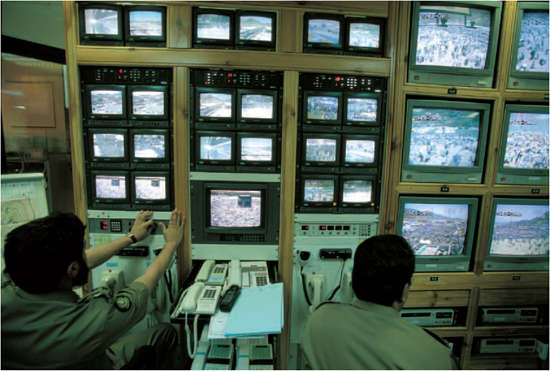
A security and crowd control room in Mina. Over 500 surveillance cameras are set up on the pilgrimage route from Mecca to Arafat.
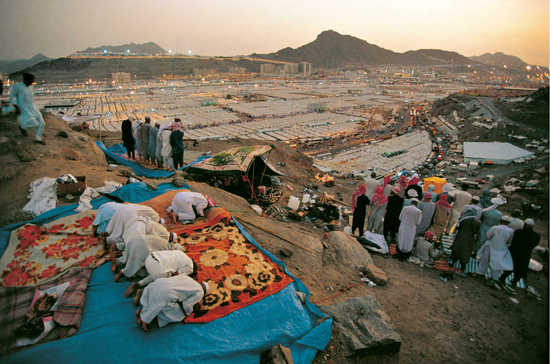
Evening (maghrib) prayers at the camping area in Mina. Most pilgrims leave this area and return to Mecca on the twelfth day but they do spend at least one night at Mina. This and other steps in the Hajj follow the precedent established by the wonts (sunnah) of the Blessed Prophet who made the pilgrimage in 10/632.
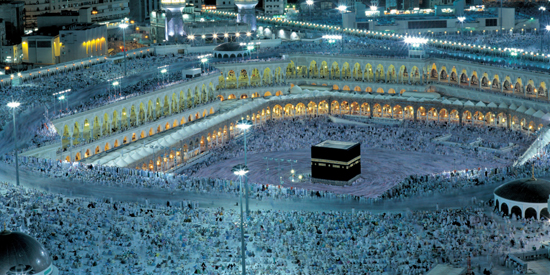
After the completion of the rites at Mina, pilgrims return to Mecca for the farewell ttawaf or circumambulation (ttawaf al-wida) at the Haram or Grand Mosque. Those who cannot enter the holy precinct, perform the ttawaf on the second floor of the mosque, in the basement or even outside the immense complex of the mosque.